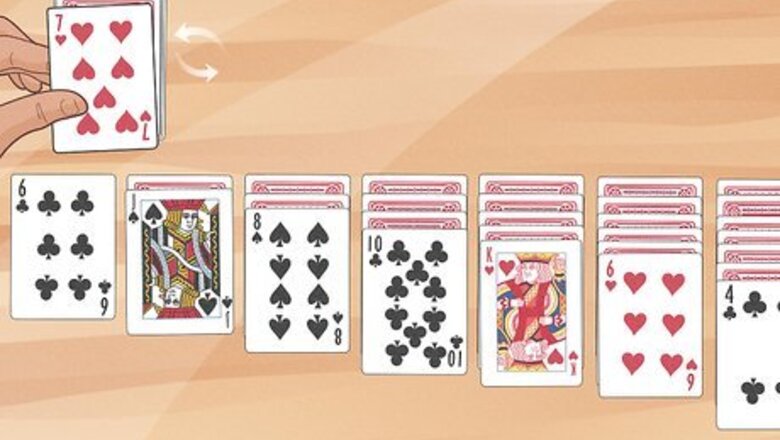
views
- Move cards in the main stacks before using extra stock cards. Clear aces and 2s to foundation piles right away to free up space.
- Free up face-down cards from the largest stacks first to have access to them. Group like suits in the same stacks so they’re easier to play through.
- Spread cards out evenly between stacks for more options to play cards from.
Flip the top stock card before making a move.

Seeing the first stock card gives you more options during your first moves. After setting up your game of solitaire, the leftover face-down deck of cards becomes the “stock” pile. Right when the game starts, immediately flip the first card over to see what it is. Knowing what card you have to work with right away can help you make more informed plays early on in your game. Example: If you have a black 6 as the only card in the first pile, a black 8 in a different stack, and a red 7 as the first card in the stock, you can now easily move them into a single stack. If you’re playing Vegas solitaire, flip only 1 card from the stock pile at a time. For classic games of solitaire, turn over the top 3 cards. You may only use the topmost card, which will free up the cards below and make them available.
Move cards in your tableau before your stock.
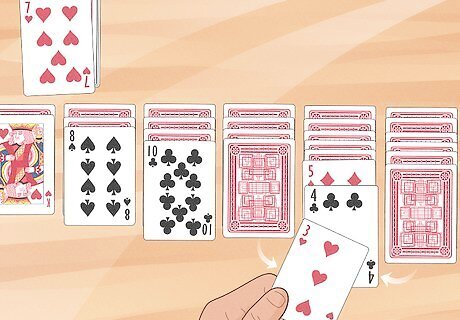
Using tableau cards first lets you access trapped face-down cards. Your tableau is made up of the 7 stacks of cards you dealt out at the start of the game. If you have the choice between moving the top card of a tableau stack or playing a card from the stock, always use the tableau card. That way, you’re able to reveal the next face-down card in the stack and use it in your game. Revealing face-down cards in the tableau gives you more access to cards, so you can clearly plot out your moves for the best chances at winning.
Put aces and 2s in foundation piles right away.

Moving aces and 2s right away stops them from clogging up your tableau. The foundation piles are the 4 stacks you’re trying to move all the cards to in ascending order. If you reveal any aces in your tableau or stock pile, immediately place them above your tableau to start the foundation pile of that suit. Once you have the ace in a foundation pile, move 2s of a matching suit onto the pile right away to free up space and reveal face-down cards. You’ll never play another card on top of a 2 in your tableau, so they only take up space. Try to move them as quickly as possible.
Focus on the largest stack face-down cards first.
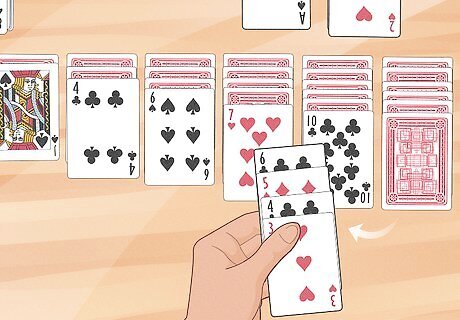
Revealing more face-down cards gives you more options for plays. Whenever you’re able to move a card off of a larger stack in your tableau, take the opportunity so you can reveal the next card below it. As you reveal more of the face-down cards, you’ll have access to stronger plays later in the game and make it easier to move cards to the foundation piles. Example: If you have a stack with 3 face-down cards and a stack with 6 face-down cards, and both have a black 7 on top, use the one on the larger pile instead.
Arrange matching suits in the same stack.

Stacks with the same suits help you move cards to foundation piles. As you gain access to more cards in your tableau, try to use the same red and black suits in one column. If possible, try to plan a second stack using those same suits. That way, when you put the aces for those suits in the foundation piles, you’ll be able to quickly move the stacked cards and free up tableau space. Example: If you have a stack that contains the 8 of clubs and 7 of diamonds, try to move the 6 of clubs and 5 of diamonds there. In a second stack, try to arrange the 8 of diamonds, 7 of clubs, 6 of diamonds, and so on. This trick works best a little later in the game when you reveal the majority of the face-down cards and kings.
Distribute cards evenly on your tableau.
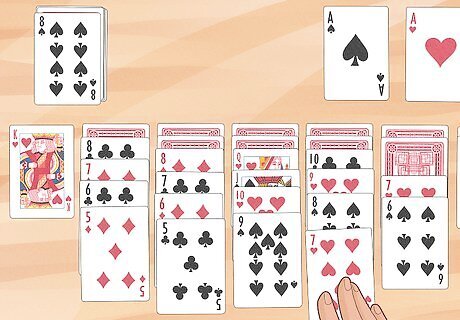
Smaller tableau piles give you more options for moving and placing cards. If you have the choice between maintaining 2 piles with 4 cards each or combining them into a large pile, leave them separated unless you’re able to reveal a face-down card after the play. Keeping your piles small and even once you reveal most of the face-down cards makes it a lot easier to place cards from your stock pile into the game.
Wait to move useful cards to foundation piles.

Keeping cards in play can help you free up lower-numbered stock cards. Even if you have an available move to place a card in one of your foundation piles, check the other cards to see what’s available and what’s still blocked. If there’s a lower-numbered card that is still in your stock pile or in a face-down stack, leave the card in place for now. Example: You have the 5 of spades in your foundation pile and the 6 of spades on a tableau stack. If there’s a red 4 on top of a different stack, it’s a better play to move that card on top of the 5 of spades. That way, you free up another face-down card and have more options. Try to keep your foundation piles even and around the same numbers. If you play too many cards into one foundation pile, you may block moves that would free up more cards.
Move 5s, 6s, 7s, and 8s if they free another card.

Playing mid-range cards carefully prevents you from getting stuck. Mid-range cards, like the 5s, 6s, 7s, and 8s, are more likely to jam up your tableau when you start moving them around the stacks. Look for other options on what to play first. However, if moving the card reveals a face-down card below it, then it’s okay to shift it to another stack of the foundation. If you do need to move a 5, 6, 7, or 8, try to place it on a stack that has the same suit so they’re easier to play to foundation piles later on. For example, if you have a 5 of spades, it’s smart to play it on a stack containing a red 6 and a 7 of spades.
Wait for a king before clearing a stack.

Putting a king in an empty stack right away frees up more plays. Kings are the only cards you can play onto an empty stack, so clearing one out too early limits where you can move cards. Keep the pile intact until you have a free king somewhere else in your tableau or stock pile. That way, you can play the king right away and have more space to play cards. If you have a choice between filling a slot on the tableau with a king from the tableau or the stock pile, choose the king in your tableau first, especially if it frees up another face-down card.
Check the colors of cards before moving a king.
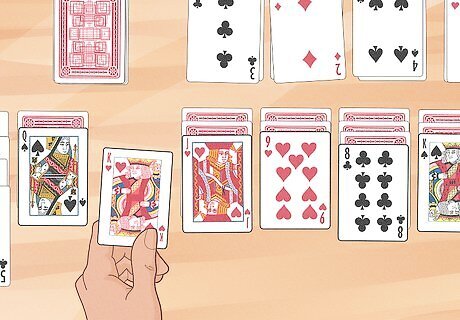
The colors of the cards in play help you determine what king is best to play. If you only have 1 free slot open on the tableau and you’re trying to figure out if you should place a black king or a red king, look at the top card on each stack. If a majority of the odd-numbered cards are red, then a red king would be best for moving and building a stack. If the odd-numbered cards are black, then place a black king instead. Example: If you have a red jack, red 9, black 8, and black queen blocking your face-down cards, a red king is a better choice for the free slot since all of those cards can be stacked on that king. If you already have a king of one color in your tableau, then place a king of the opposite color in an open stack if you’re able to.
Play cards quickly in a timed solitaire game.
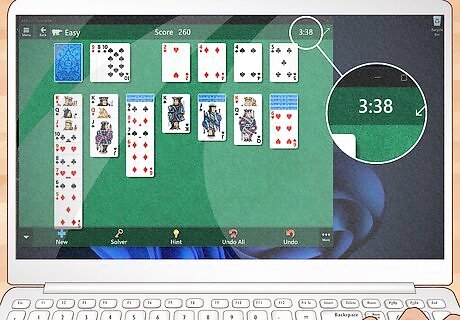
Play cards quickly if you’re playing timed solitaire. While you can play solitaire at your own pace, some online games and competitive tournaments count time towards a final score. Look through your options quickly and try to make the best possible play as fast as you can. That way, you may get bonus points for having extra time at the end of your game. Some versions of online solitaire have an undo button that allows you to take cards from the foundation and put them back on the tableau, but it may come with a time and score penalty.
Redeal the cards if you get really stuck.

It may not be possible to win the game after a bad deal or play. Even though many games of solitaire are “solvable” and have a way to win, sometimes cards you need just get stuck in a stack without a way to access them. If you’ve gone through all the strategies and still can’t find a legal move, then it’s best just to start over with a new game and try again. Example: If an ace is stuck underneath a card that you’re unable to move to another stack, then you won’t be able to win the game.



















Comments
0 comment